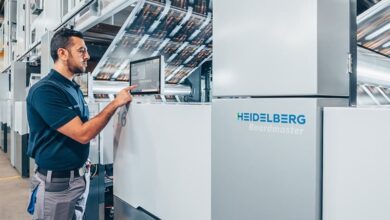HP Offers A Wide-Range of Sustainable Printing Solutions
How does HP make sure it is contributing to the print sustainability cause?
Sustainability guides how we design, manufacture, and operate every day. It’s the connecting fabric of the full value chain, from the people who make our products to those who use them every day.
With a full lifecycle approach, products are manufactured based on highest ethical standards for people, and materials that we use. Striving from design, to improve performance, reduce waste and move towards a more circular economy with service based models and take back programs.
From our operations perspective, HP has publicly committed to reduce our CO2 footprint, to move to renewable electricity and to achieve zero deforestation for our papers. These comprehensive goals and actions have gained the recognition as one of the most sustainable companies in the world.
Economic concerns, technological threat and uncertain futures have contributed to a crisis of confidence in print. Do you agree to this statement? If yes, what more needs to be done?
I don’t agree that print is in crisis today. Printing as a technology has been challenged, not reporting much in the way of growth over the last five years or more. But HP is driving, a print renaissence, growing again from our leadership position. In our graphics printing solutions business, for instance, we’ve been untapping incremental opportunities and applications that have fueled a continued year on year growth, for quite a few years now. Decoration, textiles, labels, packaging, and 3D printing are areas for continued growth moving forward.
What sort of factors are shaping today’s print industry?
With the emergence of new technology and the penetration onto new applications, digital printing and digitally printed applications are representing a bigger portion of the overall printing industry. As such, regulations are having and additional focus to upgrade and include digital printing into their scope. Hazardous inks, air quality, recyclability are key areas where less sustainable technologies will struggle to stay in compliance to new regulations.
From the customers perspective, Innovative brands are leveraging the advantages of digital (more agility, shorter runs, and personalization) for their business success. Investing time from brands to explore new possibilities, and from Printing companies to support these explorations, is part of the driving force to digital printing adoption.
What are the challenges that block the pathway towards sustainability in the printing industry?
The inertia of print buyers requesting old known technologies to do their jobs, plus the lack of awareness of newer and more sustainable technologies, are the key challenges to adoption of more sustainable solutions.
Awareness of how digital technologies are enabling printing on demand, reducing inventory waste due to overproduction and obsolescence. Or how water based solutions (such as HP Latex Technology) can provide healthier and more sustainable solutions for signage and decoration market versus older technologies like solvent or UV.
New media options, digital technology implementations and green expectations can breed market uncertainty. In such a scenario, how can printers make sure their new investments can bring in maximum RoI?
Digital printing continues to be a great investment. The technology advancements and price/productivity improvements are enabling digital printing to penetrate into new applications. There are applications where digital media will penetrate and displace print, but many others are appearing and compensate the decline.
New investments need to anticipate these changes and choose leading technologies and suppliers, that allows the printing company serve these new applications. Versatility of the technologies chosen will also be very relevant, to be able to adapt quickly to new applications. And the last key factor for a printing company to succeed is focusing on market development. Untapping new applications require focus from the printing company to educate the industry and walk the customers to the new possibilities of digital print.
How according to you can printers reshape their businesses by aligning commercial and environmental goals?
Business practices to achieve commercial goals are not necessarily opposite to environmental goals. In fact, report shows that innovative companies can develop processes and solutions that are good for business and good for environment.
Independent organisations are promoting sustainability practices in printing and manufacturing operations through education and certification program. HP is platinum partner of Sustainable Green Partnership (SGP), that has this objective in the US. From HP’s side, the HP EcoSolutions Training program helps companies to gain new knowledge and to assist clients looking for wide format graphics solutions with a reduced environmental impact. It is a free, web based interactive training covering the fundamentals to better combine business and environment.
Do you believe use of renewable resources can pave way for sustainability? If yes, what initiatives has your company taken to make sure your products and solutions offer ecological benefits?
As we continue to reinvent a more sustainable business and society, both cost-effective and low carbon sources of energy are essential to the future. Technology and sustainability can combine to become a powerful force for innovation, helping reinvent how businesses, communities, and individuals can thrive.
HP has publicly committed to to move to renewable electricity to continue leading this transformation in the industry.
In regards to HP brand paper and paper-based product packaging, HP has committed that all of them will be derived from certified and recycled sources by 2020.




